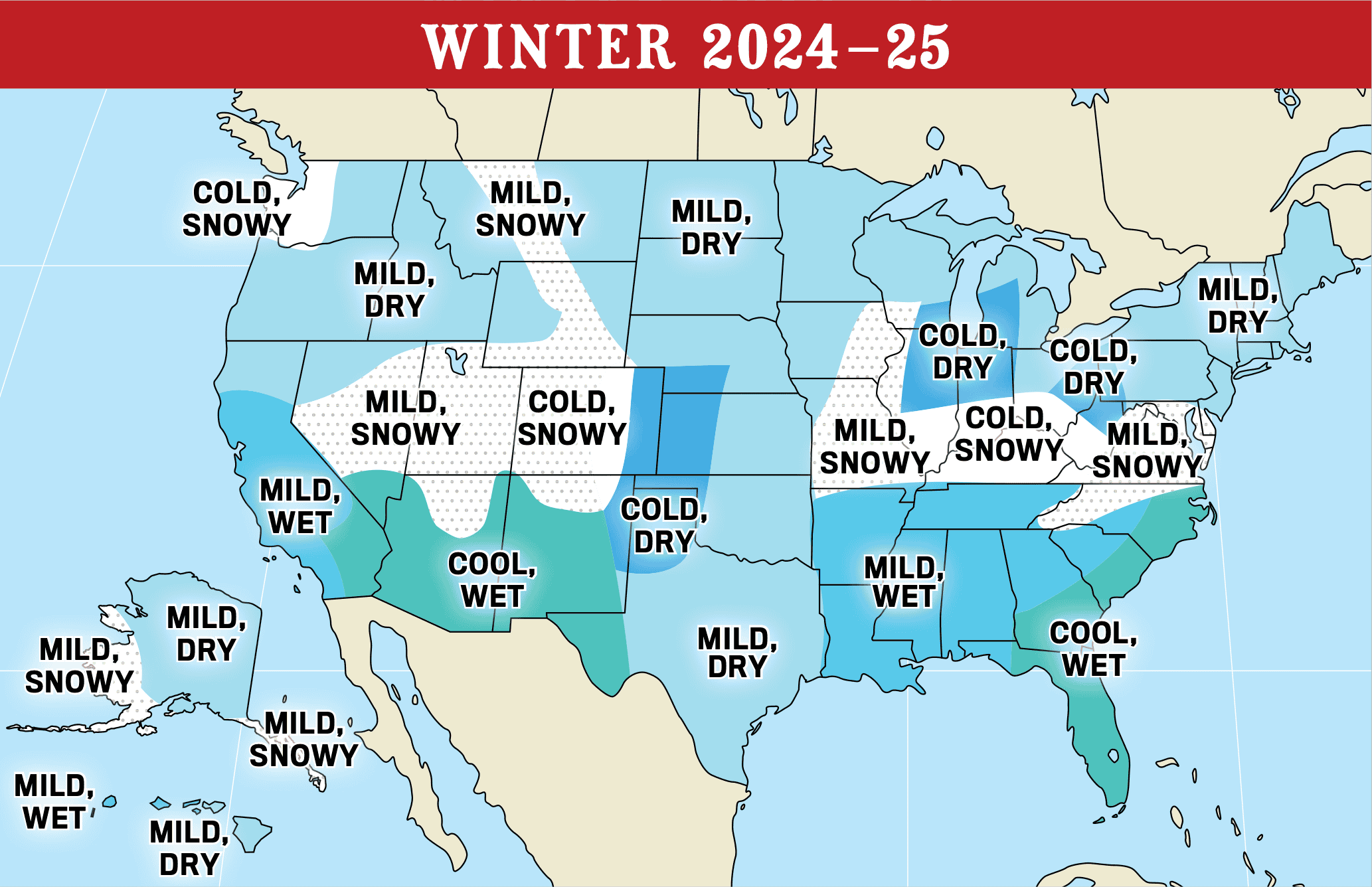
Guess what? It will snow this winter, I can promise you that. Yay! But what we all want to know is, how much and where? Well, the Old Farmer’s Almanac (not to be confused with the Farmers’ Almanac) has just released its long-range winter weather forecast for the 2024-25 season. For over 230 years, the Almanac has been helping readers prepare for winter’s worst with its 80 percent–accurate weather forecasts.
The 2025 Old Farmer’s Almanac predicts a calmer, gentler winter for 2024-2025. “This winter, temperatures will be up and snowfall down throughout most parts of the United States,” reports Carol Connare, the Almanac’s editor. “While there will still be plenty of winter chill out there and powdery snow to enjoy, the high costs associated with the season shouldn’t hit so hard. It will be, by and large, a very temperate, uneventful winter and potentially a welcome reprieve from the extremes of recent years.”
There will be exceptions, of course. Winter rain- storms will leave Florida, the Deep South, and southern California sopped and soaked. Meanwhile, heavy snowfall is expected in central and southern Appalachia, the western Ohio Valley, and the Rockies— welcome news for skiers. Western Washington will buck the overall forecast trend with a season of shivers and a series of snowstorms starting around New Year’s Eve and more or less continuing through Valentine’s Day. A more moderate winter will eventually lead to a sweltering summer, especially for folks without air-conditioning.
Here’s a summary of the Old Almanacs’ winter forecast broken down by mountain regions across the United States:
Tl;dr: This winter forecast suggests that the best overall conditions for skiing and snowboarding will be found in the Intermountain Region, Southeast Mountains, and northern Pacific Northwest. Other regions will still offer good opportunities, but may require more careful planning to catch the best snow days.
Northeast (Including Eastern New York)
Winter temperatures will be above average, with the coldest periods in mid-December and late February. Snowfall will be slightly below normal, but there will still be plenty of snow for skiing and snowboarding. The best times to hit the slopes will be in early December, mid-February, and early March.
Appalachians
Expect a milder winter with temperatures slightly warmer than normal. Snowfall will be average in the northern Appalachians and above normal in the southern parts. Ski enthusiasts should plan their trips for late December, late February, and early March when the snowiest periods are expected.
Southeast Mountains (North Carolina, Georgia)
The winter will be cooler than normal in the eastern parts of this region. Snowfall is predicted to be above normal. The best chances for fresh powder will be in late January and early and late February.
Lower Lakes Region
Winter temperatures will vary, being warmer in the east and colder in the west. Snowfall is expected to be below average, which might disappoint some winter sports enthusiasts. However, there will still be opportunities for skiing and snowboarding, particularly in late December, late January to early February, and late February to early March.
Upper Midwest
While temperatures will be milder than usual, snowfall is predicted to be below average. Ski resorts in this region may face challenges, but there will still be good skiing opportunities. The best times to visit will be in late November, late December, mid- and late January, early February, and mid-March.
Rocky Mountains (High Plains and Intermountain Regions)
High Plains: Expect a mix of temperatures, with warmer conditions in the north and colder in the south. Snowfall will be near to above normal, providing good conditions for winter sports. The best periods for fresh snow will be mid-November, mid- and late January and February.
Intermountain Region: This area will be a winter sports paradise with average to above-average snowfall and above-normal temperatures. Plan your trips for mid-November, early and late January, and mid-March to catch the snowiest periods.
Pacific Northwest
Skiers and snowboarders heading to the northern parts of this region will enjoy above-average snowfall, while the southern areas will see below-average precipitation. Temperatures will be colder than normal in the north and warmer in the south. The best times for winter sports will be late December, early January, and early February.
Sierra Nevada
Expect above-average snowfall in the northern areas, with the best skiing conditions in late December, early January, and early February.